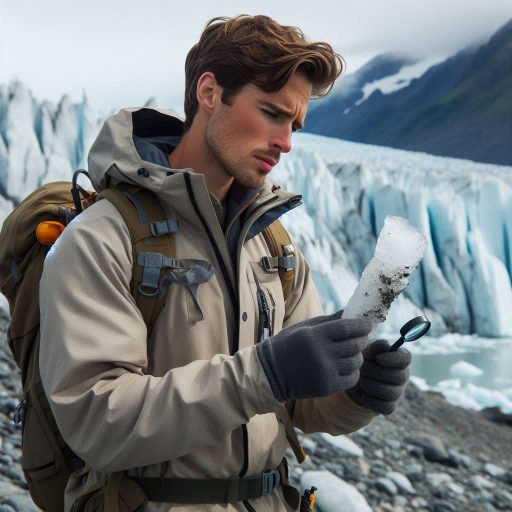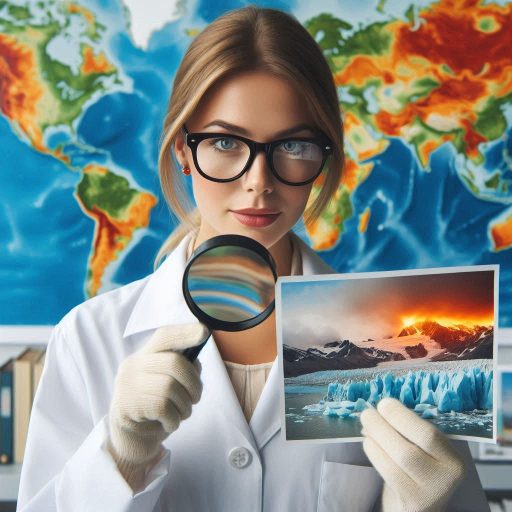Introduction
Climatologists and meteorologists both study the atmosphere but focus on different aspects.
Climatologists analyze long-term climate patterns, trends, and changes over decades or centuries.
They investigate how climate influences ecosystems, agriculture, and human activity.
Their work helps us understand climate change and its effects on the planet.
Meteorologists, on the other hand, study short-term weather events and forecasts.
They focus on predicting daily and weekly weather conditions.
Meteorologists analyze data from satellites, radar, and weather stations to provide timely forecasts.
Their work is crucial for public safety during severe weather events.
Although their fields overlap, climatologists and meteorologists have distinct roles.
Climatologists emphasize long-term trends and historical data, while meteorologists concentrate on immediate weather patterns.
Both professions are essential for understanding the complexities of the Earth’s atmosphere.
Together, they provide valuable insights into climate and weather, helping society adapt to environmental changes.
Understanding these differences enhances our appreciation for their contributions to science and society.
Exploring both fields can inspire future generations of scientists and researchers.
Education and Training
Climatologists and meteorologists have distinct educational paths that reflect their different focuses.
Understanding these paths helps aspiring professionals choose their career.
Different Educational Requirements
Meteorologists often hold a bachelor’s degree in meteorology or atmospheric sciences.
This degree provides a strong foundation in weather analysis and forecasting.
Some universities offer specialized meteorology programs tailored to this field.
Many meteorologists further their education with a master’s or doctoral degree.
Advanced degrees deepen knowledge in specific areas of weather science.
On the other hand, climatologists usually pursue degrees in climatology, environmental science, or related fields.
They often obtain a bachelor‘s degree in geography or earth sciences.
Some universities offer specific programs focusing on climate studies.
Climatologists often engage in interdisciplinary studies, combining knowledge from multiple scientific disciplines.
This broader educational approach equips them to analyze climate patterns and changes over time.
Specialized Coursework and Degrees
Both climatologists and meteorologists complete rigorous coursework relevant to their fields.
Meteorology students study subjects such as atmospheric dynamics, thermodynamics, and weather forecasting techniques.
They learn to use computer models for predicting weather patterns.
Meteorologists also gain skills in data analysis and interpretation, critical for accurate forecasting.
In contrast, climatology students focus on courses like climate modeling, paleoclimatology, and statistical analysis.
They study historical climate data to understand long-term trends.
Climatologists often delve into environmental policies and climate change impacts.
This diverse coursework prepares them to address global climate issues effectively.
Importance of Internships and Hands-On Experience
Internships play a vital role in both meteorology and climatology.
Practical experience enhances theoretical knowledge gained in the classroom.
Meteorology students often seek internships with weather stations or broadcasting companies.
These opportunities allow them to apply their skills in real-world settings.
Internships help meteorology students develop forecasting techniques and gain valuable networking connections.
Climatology students also benefit from internships, particularly in research settings.
They often work with government agencies or research institutions.
These internships allow them to collect and analyze climate data.
Hands-on experience fosters critical thinking and problem-solving skills in climatology students.
Many climatologists engage in fieldwork, studying climate impacts in various regions.
Both climatologists and meteorologists require strong educational foundations.
Their paths differ significantly, reflecting their unique focuses on weather and climate.
Specialized coursework prepares them for their respective careers.
Additionally, internships provide essential hands-on experience.
This combination of education and practical application equips graduates for success in their chosen fields.
Understanding these differences is crucial for anyone considering a career in atmospheric sciences.
Read: Challenges and Rewards: The Dual Life of an U.S. Environmental Scientist
Job Responsibilities
Climatologists and meteorologists play vital roles in understanding our atmosphere.
However, their job responsibilities differ significantly.
Climatologists focus on long-term climate patterns, while meteorologists concentrate on short-term weather events.
This section explores their specific tasks and duties.
Climatologists: Long-Term Climate Patterns
Climatologists analyze climate data over extended periods.
They study trends and variations in temperature, precipitation, and wind patterns.
These professionals assess how human activities impact the climate.
They research historical climate data to identify patterns.
One primary task for climatologists is conducting climate modeling.
They use complex computer models to predict future climate scenarios.
These models help them understand potential climate changes over decades or centuries.
They often analyze data collected from various sources, such as satellites and weather stations.
Climatologists also publish research findings in scientific journals.
This work helps inform policymakers about climate change issues.
They participate in conferences to share insights with other scientists.
Additionally, they may collaborate with government agencies or non-profit organizations.
Their goal is to develop strategies to mitigate climate-related impacts.
Meteorologists: Short-Term Weather Events
Meteorologists, on the other hand, focus on short-term weather events.
They analyze data to provide accurate weather forecasts.
Meteorologists examine atmospheric conditions, such as temperature and humidity, to predict daily or weekly weather.
They monitor severe weather events, like storms or hurricanes, and issue warnings to the public.
One common task for meteorologists is preparing weather reports.
These reports include temperature predictions, precipitation chances, and wind speeds.
They often present these reports on television or radio.
In addition, they update social media platforms to reach a broader audience.
Meteorologists utilize advanced technology for weather forecasting.
They rely on radar systems to track storm movements.
They also use satellite imagery to observe weather patterns from space.
This technology allows them to provide timely updates on changing conditions.
Meteorologists frequently collaborate with emergency management teams.
They help these teams prepare for severe weather events.
By providing accurate forecasts, meteorologists contribute to public safety.
Their expertise is crucial during natural disasters, ensuring communities receive timely information.
Specific Tasks and Examples
Both climatologists and meteorologists have distinct tasks that define their roles.
Climatologists might analyze historical temperature records for long-term trends.
They could also create reports on the potential impacts of climate change.
For instance, they may assess how rising temperatures affect sea levels.
Conversely, meteorologists might issue severe weather alerts during a tornado watch.
They can provide hourly updates on storm developments.
They often prepare visual forecasts using maps and graphics to enhance understanding.
Climatologists and meteorologists serve different purposes.
Climatologists focus on long-term climate patterns, while meteorologists monitor short-term weather events.
Each profession has specific tasks that contribute to our understanding of weather and climate.
Read: Job Market Trends: Future of Chemistry Jobs in America
Data Collection and Analysis
Climatologists and meteorologists rely on distinct methods to collect and analyze data.
Understanding these methods reveals their different approaches to studying the atmosphere.
Methods of Collecting Climate Data for Climatologists
Climatologists focus on long-term climate patterns.
They collect data from various sources, including weather stations, satellites, and ocean buoys.
These instruments record temperature, precipitation, humidity, and wind speed over extended periods.
Climatologists also use paleoclimate data, which includes ice cores, tree rings, and sediment samples.
This data provides insights into historical climate changes.
They analyze these long-term trends to understand how climate systems function and evolve.
Remote sensing technology plays a crucial role in climate data collection.
Satellites equipped with advanced sensors gather information about the Earth‘s surface.
This data includes changes in land use, sea level rise, and glacial retreat.
Climatologists combine this information with models to project future climate scenarios.
They often collaborate with other scientists, sharing data to improve accuracy in climate predictions.
Techniques Utilized to Gather Weather Data for Meteorologists
Meteorologists focus on short-term weather patterns and forecasts.
They primarily use weather stations to collect real-time data.
These stations measure temperature, humidity, atmospheric pressure, and wind speed.
Meteorologists also utilize radar systems to detect precipitation and storm systems.
Doppler radar technology helps track severe weather events like tornadoes and hurricanes.
Additionally, meteorologists rely on weather balloons, which gather data at various altitudes.
These balloons measure temperature, pressure, and humidity in the upper atmosphere.
This information is vital for understanding weather patterns and making short-term predictions.
Meteorologists also use computer models to simulate weather systems and predict future conditions.
They continuously update these models with real-time data to improve forecasting accuracy.
Analysis Processes for Both Professions
Both climatologists and meteorologists analyze data to make predictions and forecasts.
Climatologists employ statistical methods to identify long-term trends and patterns.
They use regression analysis to understand relationships between different climate variables.
This analysis helps them project future climate conditions based on historical data.
In contrast, meteorologists focus on real-time analysis for immediate forecasts.
They analyze weather data using numerical weather prediction models.
These models utilize complex algorithms to simulate atmospheric behavior.
Meteorologists interpret the output from these models to make short-term forecasts.
Both professions face challenges in their analysis processes.
Climatologists must account for natural variability in climate data.
Meteorologists deal with the unpredictability of weather systems.
Despite these challenges, both use advanced tools and techniques to provide valuable insights.
Climatologists and meteorologists employ different methods to collect and analyze data.
Understanding these processes highlights their unique approaches to studying our atmosphere.
Each profession plays a crucial role in advancing our knowledge of climate and weather.
Read: Challenges and Rewards: Navigating the Chemist Career Path

Tools and Technology
Climatologists and meteorologists rely on different tools and technologies to fulfill their unique roles.
Understanding these tools helps clarify their distinct functions in climate and weather research.
Equipment Used by Climatologists
Climatologists study long-term climate trends.
They often use various tools to collect data over extended periods.
One essential piece of equipment is the ice core drill.
This tool extracts ice cores from glaciers and polar regions.
By analyzing these cores, climatologists can uncover historical atmospheric conditions.
Another critical instrument is the sediment core sampler.
This device collects sediment samples from lakes and ocean floors.
Analyzing these samples reveals past climate changes and events.
Climatologists also rely on weather stations and satellite data.
These resources provide essential climate information, such as temperature, humidity, and precipitation trends over time.
Instruments Employed by Meteorologists
Meteorologists focus on current weather conditions and short-term forecasts.
They utilize several specialized instruments to monitor these factors.
One of the most common tools is the anemometer.
This device measures wind speed and direction.
Meteorologists use it to assess weather patterns and predict storms.
Radars play a significant role in meteorology as well.
Doppler radar helps meteorologists track precipitation and storm systems.
This technology provides real-time data on rainfall intensity and storm movement.
Additionally, meteorologists use barometers to measure atmospheric pressure.
Changes in pressure can indicate upcoming weather changes, such as storms or clear skies.
Transform Your Career Today
Unlock a personalized career strategy that drives real results. Get tailored advice and a roadmap designed just for you.
Start NowAdvancements in Technology
Technology has significantly advanced in both climatology and meteorology.
Satellite technology has transformed how scientists observe the Earth’s atmosphere.
Satellites provide real-time images of weather systems and climate patterns.
This information enables both fields to make more accurate predictions.
Moreover, computer modeling has revolutionized climate and weather forecasting.
Advanced simulations allow climatologists to predict future climate scenarios based on current data.
Meteorologists can also utilize these models to forecast short-term weather patterns with greater precision.
Remote sensing technology enhances the study of climate and weather as well.
It enables scientists to gather data from inaccessible locations.
Instruments like LIDAR and ground-based remote sensing help analyze atmospheric components.
These advancements improve the understanding of climate change and its impacts.
Finally, artificial intelligence (AI) plays a growing role in both fields.
AI algorithms analyze vast amounts of data quickly.
They can identify patterns and trends that human analysts might miss.
This capability leads to more informed decisions regarding climate action and disaster preparedness.
Climatologists and meteorologists utilize distinct tools and technologies to fulfill their research roles.
Understanding these tools highlights the key differences between the two fields.
Continuous advancements in technology improve the accuracy of climate studies and weather predictions, benefiting both disciplines and society as a whole.
Read: Diverse Career Paths: From Chemist to Patent Attorney in the US
Career Opportunities
Both climatologists and meteorologists have diverse career opportunities across various sectors.
They play crucial roles in understanding and managing weather patterns and climate changes.
The industries employing these professionals range from government agencies to private companies.
Industries Employing Climatologists and Meteorologists
Climatologists typically work in research institutions, government agencies, and non-profit organizations.
They analyze climate data and contribute to policy development.
Meteorologists, on the other hand, find employment in television stations, radio, and online weather services.
They also work for governmental organizations like the National Weather Service (NWS) and the National Oceanic and Atmospheric Administration (NOAA).
Different Roles Within Government Agencies
In government agencies, climatologists often focus on long-term climate analysis.
They study trends that inform policy decisions related to environmental issues.
Meteorologists in these agencies provide timely weather forecasts and warnings.
They utilize advanced technology to analyze real-time data and inform the public.
Research institutions employ climatologists for in-depth studies on climate change impacts.
These roles often involve working with interdisciplinary teams.
Meteorologists at research institutions focus on understanding weather patterns and developing forecasting models.
Private Sector Opportunities
In the private sector, climatologists work for consulting firms, helping businesses adapt to climate risks.
They analyze climate data to provide insights on sustainability.
Meteorologists in the private sector often work for weather service companies.
They provide weather forecasts for businesses, agriculture, and event planning.
Many meteorologists also specialize in climate risk assessment for insurance companies.
They analyze data to help companies mitigate financial risks related to weather events.
Opportunities for Advancement
Both professions offer numerous opportunities for advancement.
Climatologists can move into leadership roles within research teams.
They may also become policy advisors for governmental organizations.
With experience, they may transition into academia, teaching future scientists.
Meteorologists can advance to chief meteorologist positions in broadcasting.
They may also specialize in certain areas, such as severe weather forecasting.
Additionally, meteorologists can take on roles in climate research, contributing to scientific knowledge.
Specialization Within Each Profession
Climatologists often specialize in specific climate-related fields.
This could include paleoclimatology, which studies historical climates.
They might also focus on urban climate studies, analyzing how cities impact local weather patterns.
Meteorologists can specialize in various aspects of weather forecasting.
Some become experts in radar technology, improving forecasting accuracy.
Others may focus on atmospheric science, studying the physical processes behind weather phenomena.
Both climatologists and meteorologists enjoy diverse career opportunities.
Their work spans multiple industries, including government, research, and private sectors.
As they gain experience, they can specialize in areas of interest and advance into leadership roles.
These professions not only offer fulfilling careers but also contribute significantly to society‘s understanding of climate and weather.
Collaboration and Communication
Importance of Teamwork and Collaboration Between Climatologists and Meteorologists
Teamwork between climatologists and meteorologists plays a vital role in advancing weather and climate science.
Both professionals specialize in studying atmospheric phenomena but have different focuses.
Climatologists examine long-term climate trends and patterns.
Meteorologists focus on short-term weather events and forecasts.
Their collaboration enhances our understanding of complex weather systems and climate change.
Need for Effective Communication to Share Findings and Predictions with the Public
Effective communication is essential for sharing findings and predictions with the public.
Clear and concise messaging helps the public understand weather forecasts and climate impacts.
Meteorologists often communicate immediate weather threats, such as hurricanes and tornadoes.
Climatologists inform the public about long-term climate changes and their consequences.
Together, they ensure that essential information reaches communities promptly and accurately.
Examples of Successful Collaborations That Have Led to Improved Understanding of Weather and Climate Patterns
Collaboration between these two fields can lead to significant advancements in understanding weather and climate patterns.
For example, researchers at the National Oceanic and Atmospheric Administration (NOAA) regularly work together on climate-related projects.
This collaboration has resulted in improved climate models and better forecasting techniques.
By pooling their expertise, they enhance their research capabilities and produce more comprehensive findings.
Another example involves the Intergovernmental Panel on Climate Change (IPCC).
This international organization brings together scientists from various disciplines, including climatology and meteorology.
The IPCC produces reports that summarize current knowledge about climate change and its effects.
These reports rely on the collaboration of climatologists and meteorologists to present a holistic view of climate-related issues.
Successful partnerships also occur at the local level.
University research teams often include both climatologists and meteorologists.
These teams study regional climate impacts and weather extremes.
Their collaboration can improve local preparedness for extreme weather events.
By working together, they can develop better risk assessment tools and strategies for communities.
In addition to research collaborations, both professions need to engage with the media effectively.
Journalists play a critical role in disseminating information to the public.
Climatologists and meteorologists must communicate their findings in ways that are accessible and understandable.
This communication ensures that the public is informed and prepared for changing weather and climate conditions.
Furthermore, effective collaboration promotes cross-disciplinary training and knowledge exchange.
Graduate programs increasingly encourage students to explore both climatology and meteorology.
This approach cultivates a new generation of scientists who understand the interconnectedness of these fields.
As they enter the workforce, they can foster greater collaboration between climatologists and meteorologists.
Teamwork and effective communication are essential for climatologists and meteorologists.
Their collaboration leads to better understanding, preparedness, and resilience against weather and climate impacts.
Gain More Insights: Day in the Life of a Professional Geologist
Impact on Society
Climatologists and meteorologists play crucial roles in understanding and addressing climate-related challenges.
Each profession contributes uniquely to our society, influencing public awareness and policy decisions.
Climatologists and Long-Term Climate Change
Climatologists focus on studying long-term climate patterns and changes.
They analyze data over decades and centuries to understand climate variability.
Their research reveals trends in temperature, precipitation, and extreme weather events.
By understanding these trends, climatologists provide insights into potential future climate scenarios.
This knowledge aids governments, businesses, and communities in preparing for climate impacts.
Climatologists often publish reports that highlight the urgency of climate action.
Their work supports global initiatives like the Paris Agreement.
As a result, climatologists significantly contribute to our understanding of climate change and its potential impacts on society.
Meteorologists and Weather Forecasting
Meteorologists, on the other hand, specialize in short-term weather patterns.
They use advanced technology and data analysis to predict weather events.
Accurate forecasts help communities prepare for severe weather, such as hurricanes or blizzards.
Meteorologists communicate vital information to the public through various media outlets.
This information helps people make informed decisions during emergencies.
Schools, businesses, and local governments rely on meteorological forecasts for planning.
Their timely warnings protect lives and property from dangerous weather.
By providing accurate weather predictions, meteorologists play a crucial role in disaster preparedness and response.
Policy-Making Influence
Both climatologists and meteorologists significantly influence policy-making decisions.
Policymakers rely on the research and data provided by these professionals.
Climatologists inform long-term strategies for mitigating climate change effects.
Their findings guide policies on renewable energy, conservation, and emissions reduction.
Meteorologists contribute to emergency management policies by providing essential weather data.
Their forecasts help develop evacuation plans and safety protocols.
Together, these professions advocate for policies that promote sustainability and resilience against climate impacts.
Public Awareness of Environmental Issues
Moreover, both climatologists and meteorologists raise public awareness of environmental issues.
Climatologists educate the public about the science behind climate change.
They conduct outreach programs, workshops, and lectures to share their knowledge.
Meteorologists, through their daily broadcasts, emphasize the importance of weather awareness.
They often discuss climate issues in relation to current weather events.
This collaboration fosters a greater understanding of environmental challenges.
As a result, society becomes more informed and engaged in climate action initiatives.
Climatologists and meteorologists profoundly impact society through their respective contributions.
Climatologists enhance our understanding of long-term climate change, while meteorologists protect lives with accurate weather forecasts.
Together, they influence policy-making decisions and raise public awareness about environmental issues.
Their combined efforts are essential in addressing the challenges posed by climate change and ensuring a sustainable future.
Conclusion
Climatologists and meteorologists play distinct roles in atmospheric science.
Climatologists focus on long-term climate patterns, while meteorologists analyze short-term weather events.
Each profession contributes valuable insights that enhance our understanding of weather and climate.
The collaboration between climatologists and meteorologists is essential for advancing scientific knowledge.
Their combined efforts lead to better forecasts and improved climate models.
Together, they help us navigate the challenges posed by climate change.
Both careers offer exciting opportunities for those passionate about science and the environment.
Individuals interested in pursuing a career in these fields should consider their strengths and interests.
A strong background in mathematics, science, and communication skills is essential for success.
Higher education programs in meteorology and climatology provide students with the knowledge and skills needed for these professions.
Engaging in internships and research projects can also provide valuable experience.
In summary, climatologists and meteorologists significantly impact our understanding of weather and climate.
Exploring these careers can lead to fulfilling opportunities that contribute to society’s well-being.
[E-Books for Sale]
The Big Book of 500 High-Paying Jobs in America: Unlock Your Earning Potential
$19.99 • 500 High-Paying Jobs • 330 pages
Explore 500 high-paying jobs in America and learn how to boost your career, earn more, and achieve success!
See All 500 High-Paying Jobs of this E-Book
1001 Professions Without a Degree: High-Paying American Jobs You Can Start Now
$19.99 • 1001 Professions Without a Degree • 174 pages
Discover 1001 high-paying jobs without a degree! Unlock career tips, skills, and success strategies for just $19.99!




